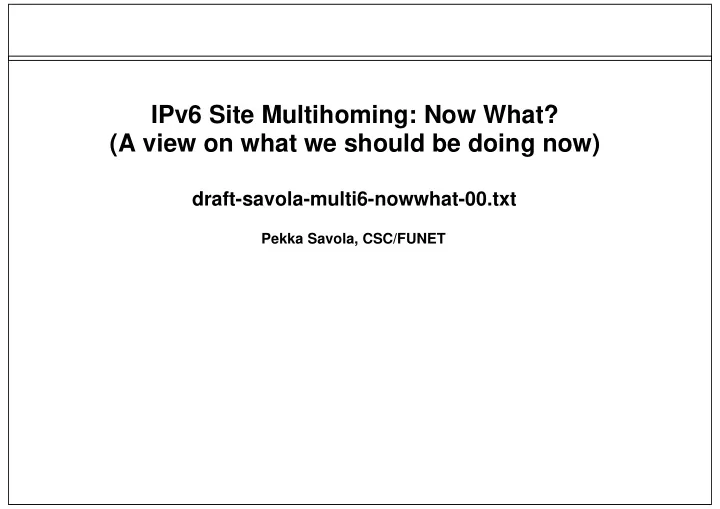

IPv6 Site Multihoming: Now What? (A view on what we should be doing now) draft-savola-multi6-nowwhat-00.txt Pekka Savola, CSC/FUNET
Now WHAT? Now WHAT? Assumptions One size fits all solutions are only possible in fantasy or a long term Different sites have different requirements and priorities Attacking the problem piecemeal should provide some way forward Approach Some analysis and classification of existing proposals (omitted here) Sites are broken down, as well as their motivations Minimal, Small, Large, International sites (on size and geographical breadth) Independence, Redundancy, Load sharing as motivations Immediate, short term and long term as possible timelines Last, look back what to do in the short term to fix/enhance multihoming solutions
Analysis and solution classification Analysis and solution classification Transport solutions TCP++, SCTP Locator/Identifier separation solutions (in the hosts) HIP, LIN6, Mobile IPv6 Host-centric multihoming (as a generic concept) Including "site exit routers" (ie. tunneling) Geographic Address Allocation "ASN-PI" Multi-connecting Others More specific routes, end-to-end multihoming, etc.
Classification of sites and motivations Classification of sites and motivations Sites Minimal: home/SOHO, fewer than 10 IP users Small: small-to-mid-size enterprise, fewer than 50-150 IP users Large: regional/national enterprise, maybe some international activity, fewer than 1000 IP users International: large/very large enterprise, significant amount of international activity Reasons Independence: switch ISP’s without a lot of renumbering etc. Redundancy: resiliency against failures, connection survivability Load sharing: too much traffic/geographically separate that must have multiple major egress points .--------------.------------.--------------. | Independence | Redundancy | Load sharing | .--------------+--------------+------------+--------------+ |Minimal | no | no | no | |Small | maybe | maybe | no | |Large | maybe/yes | yes | maybe | |International | yes | yes | yes | ’--------------’--------------’------------’--------------’
Multihoming mechanisms Multihoming mechanisms, by timeline Immediate Multi-connecting Host-centric + MH at site exit routers w/o ingress filtering Short term Host-centric + MH at site exit routers fleshed out� "ASN-PI" or advertising more specific routes from designated block Long term Transport solutions (possibly) Identifier/Locator separation in hosts Architecturally HIP is the most credible MIPv6 could possibly used as a hack with some work LIN6 a poor man’s HIP, with IPR issues Geographic address allocation (if viable at all) End to end multihoming (rather radical changes) MHAP or other mapping mechanisms in the network
Multihoming mechanisms, conclusions Multihoming mechanisms, conclusions Generic Multi-connecting good, should be used more Id/Loc in hosts will prevail (most likely ~HIP) but they won’t solve the whole multihoming problem Site-specific conclusions Minimal: no requirement for multihoming, or plain host-centric without frills Small: multi-connecting or host-centric w/ multiple PA Large: as with Small, or possibly ASN-PI International: one ASN-PI block or each country/region as a large site of its own
Work to be done in the short term Work to be done in the short term Update and finish documenting v4 multihoming Try to understand v4 multihoming better (especially the "Why") Finish documenting multihoming goals (almost done) Realize that there are multiple major problems Connection survivability is just *ONE* of them Try to minimize the need for connection survivability Create/get consensus on a roadmap how to proceed Work on short-term solutions Host-centric/site-exit when ISPs use Ingress Filtering Host-centric/site-exit when uplink MTU isn’t bigger than 1500 Work on procedures how to draw the lines between different multihoming site types (who is "privileged" for what) Start documenting how to do renumbering or how to make it easier
Discussion Discussion One size fits all vs piecemeal solutions? "Architectured solutions" vs "available solutions"? If the former, need for solutions before "master plan" is perfected? How to deal with "difficult" requirements? Especially, what level of TE is considered "valid"? Does classification to sites/motivations seem valid? Do the immediate/short term solutions selected seem valid? Do the future work item suggestions seem valid?
Recommend
More recommend